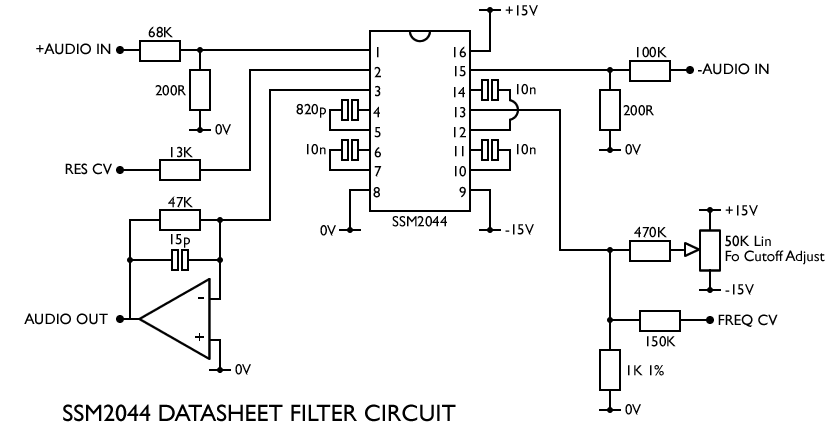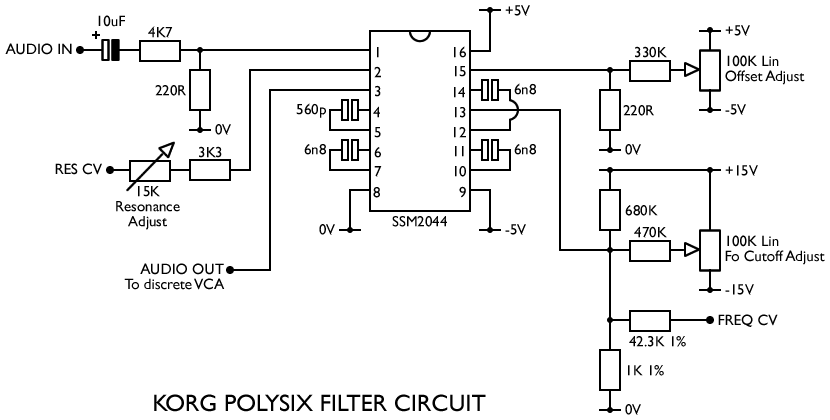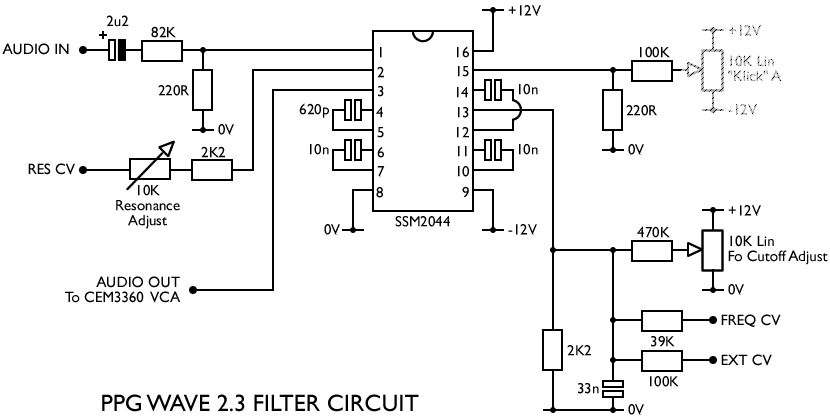This page is a look at how various synths implemented the SSM2044 filter, with the datasheet design as a reference standard. I’ve redrawn all the schematics to make comparisons very easy.
First, the datasheet design.
The datasheet suggests using the two differential inputs (+audio and -audio) as individual oscillator inputs for a two-oscillator synth (or synth voice). It also suggests that these two inputs should be provided with slightly different resistor values (68K Vs 100K) so that the oscillators don’t cancel completely when beating against each other.
Korg PolySix
Korg used the SSM 2044 in various synths. The Polysix is quite an interesting case, as it runs the chip on +/-5V. This probably entails some of the other component changes. The Polysix only has a single oscillator, so it uses the second input to cancel any DC offset on the output.
Korg MonoPoly
Although the MonoPoly has four oscillators, it also only uses one of the signal inputs on the chip, instead using an op-amp mixer (not shown) to mix the oscillator signals. The circuit is very similar to the Poly6, except the MonoPoly uses the more common +/-15V supply. Note the 100nF supply decoupling around the chip, too.
Korg Trident
I read a forum recently where someone claimed that SSM2044 filters sound better or worse depending what circuit they’re in, and said the filter from the Trident was much better than the one in the Polysix. “Hum! How interesting!“, I thought, and went off to find the circuit diagram. Here it is, and it’s virtually identical to the Polysix design. There is no way on God’s earth that this sounds markedly different from the Polysix filter. Moral of the story: Don’t believe every “expert” opinion you read on a web forum! (but you knew that already, right?)
PPG Wave 2.3
I don’t know whether the earlier versions of the PPG Wave used this same filter circuit or not. This one was copied from the service notes for the 2.3. Note that it includes an apparently optional trimmer for output offset voltage, called ‘Klick A’. Nope! See Till Kopper’s comment below for the real reason it’s there.
Siel Opera 6
Siel’s design uses a slightly different arrangement for the Frequency CV input (pin 13). I haven’t shown the CV mixer. It also uses pin 1 (+signal input) as a mixer for the oscillator and noise signals. The design also uses supply decoupling, like the MonoPoly.






https://electricdruid.net/ssm2044-lp-filter-designs is a nice informative page.
The PPG wave 2.2 and 2.3 are identically in the filter section. And “Klick A” is a click feed from the sequencer section into just one of the eight voice as the metronome click.
And I wonder what the sound difference for different capacitors around the SSM 2044 is. One day I should do this on a breadboard to get all other parts of the sound identically.
Keep on turning these knobs
Till Kopper
No radical differences, otherwise adding the range of control voltages and signal levels would help correlated the differences in component values?
Yes, certainly for some of the component value changes, different signal levels and control voltages account for the differences. As far as “radical” differences go, everyone seems to have used the SSM2044 as it was intended – as a simple lowpass filter – so the circuit doesn’t vary much. That’s not true of the CEM3320, where there are many different filters built with the chip, or even the CEM3372 which was the chip used for the famous Xpander/Matrix12 multimode filter.
This is a great page, I’m tempted to breadboard them all, to see if I can hear a difference!
I son’t suppose you know if there is a similar resourse for the SSM2045 chip? I’d love to see some of the variations that have been made with that too
For the SSM2045, I haven’t written one yet! But just speaking generally, it was a much later chip and not so widely used, so there aren’t so many examples.
I would love for you to do a similar page for the SSM2045. Mainly because I have 8 NOS 2045s with ’83 date codes. The datasheet shows some significant differences in the ‘typical examples’, and I would like to see an example or two if any manufacturers used the additional VCA.
Thanks, Tom, for all the excellent information in these pages.
Very nice page, Tom. It’s one that I have referred to many times over the years. One small correction on the PolySix, the FREQ CV resistor should be 43.2K.
So it should! I’ve put it down as 42.3K instead. Well spotted! Thanks James.
Just wanted to point out to anyone building these circuits with the SSM2144 clone that the pinouts have been completely rearranged from the original chip! I just spent the past two days scratching my head and double and triple checking all my work (not finding any mistakes) only to finally pull out the datasheet and read the sentence “pin connections were revised for PCB layout ease”. Oooof.
Anyhow, thanks for this page! A few jumper leads and we’re hopefully back in business.
A few years late to this page, but there may well be significant differences between the sound of the Polysix and the Trident filters, despite the general similarity in the circuit — but without knowing more about the oscillators it’s hard to be sure. The Polysix schematic here includes an AC coupling cap, and the Trident doesn’t. If the input signal is hot enough to produce some distortion, and not centered on 0V, the resulting harmonics will be distinctly different.
I’ve worked with the similar, modern SSI2144, and it has a very pleasant distortion when slightly overdriven. I haven’t tried biasing the input signal to get asymmetric distortion, but it might be an interesting experiment.
Do you think that is possibile to replace 1:1 a 2044 with a ssm2144 soldered in the adapter that rearrange the pinout? I’m esperimenting this solution into a Wersi CX-1 and the component oscillates.
To’ stop the whistle i modified the Q, but sound is now different. Are these components similar in electrical ? Where I can find both datasheets? Thank you for help me.
It’s absolutely possible! In fact, it’s already been done!
https://synthcube.com/cart/ssi2144-smt-vcf-ic-adapter-pcb
https://modularaddict.com/parts/pc/ssi2144-to-ssm2044-conversion-pcb
https://synthcube.com/cart/ssm2044-drop-in-replacement-pcb-adapter-for-ssi2144-smt-ic